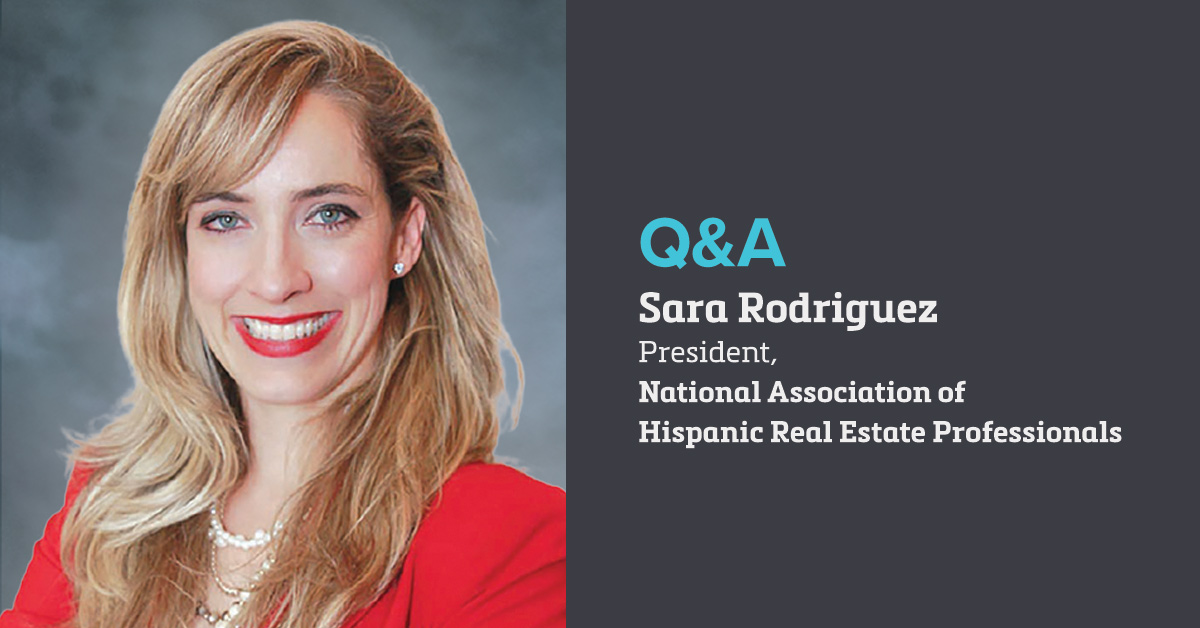Between 2020 and 2040, 70% of all new homeowners in the U.S. will be Hispanic, the Urban Institute projects. To look at it another way, in 1990, only 7.3% of U.S. households headed by someone under age 65 were Hispanic.
In 2020, this share had more than doubled to 16.4%, according to the Urban Institute. And by 2040, 20% of these younger households will be Hispanic, or three times the share in 1990. It’s clear that Hispanics and Latinos are becoming a major force in the marketplace.
The National Association of Hispanic Real Estate Professionals (NAHREP) produces an annual State of Hispanic Homeownership Report, as well as separate rankings of Hispanic mortgage originators and real estate agents. Sara Rodriguez, NAHREP’s 2020-21 president, spoke to Scotsman Guide via email about this emerging demographic.
There’s a surge in the number of Hispanics and Latinos who are reaching homebuying ages, correct?
That’s correct. Latinos are the youngest ethnic/racial demographic in the country. With a median age of 29.8, Latinos are almost a decade younger than the general population and nearly 14 years younger than the non-Hispanic white population.
Is the population growth occurring in certain states or all over the U.S.?
Latinos are driving population growth all over the U.S., but it’s more pronounced in some states. The states with the largest population growth for Latinos are Texas, California and Florida — all of which have added more than 1.4 million Latinos since 2010.
How should mortgage originators appeal to this market?
Latinos tend to have lower downpayments and are concentrated in higher-cost markets than the general population. Latinos are also more likely to live in multigenerational households and manage their finances differently. Having loan products that meet the needs of the Latino consumer is critical. While not every Latino borrower will require these products, real estate agents want someone that can work with all of their buyers, not just their prime, W-2 income borrowers.
Real estate is a networked business, and buying a home is often the largest and most overwhelming transaction families engage in during their lifetime. A Latino loan officer will be more likely to convert their community of friends and relatives into homeowners. Simply having physical office locations in predominately Latino neighborhoods will make it easier to hire Latino staff and access the Latino market. First-time homebuyers rely on their network — meet them where they are.
Having loan products that meet the needs of the Latino consumer is critical.
In the past 20 years, the number of Hispanic homeowners has more than doubled, but the homeownership rate has stayed the same. Why is that?
The Hispanic homeownership rate is a little higher today than it was in 2000 when it was 46.3%. NAHREP estimates the homeownership rate in 2020 increased within the range of 48% and 49%.
However, the growth in homeownership rate, perhaps seemingly small, has been particularly remarkable because homeownership rates are based on the amount of households in the U.S. While the number of Latino homeowners has doubled, the amount of household formations has also almost doubled, making the homeownership-rate increases that much more impressive.
How is the housing-inventory shortage affecting Hispanic and Latino homebuyers?
Because Latinos are more likely to use loan products with lower downpayments, such as FHA (Federal Housing Administration) or downpayment assistance, we are seeing Latino homebuyers being put at a disadvantage. These programs and products often take longer to close, and sellers have prioritized conventional and cash buyers at the expense of many first-time Latino families.
Steep pricing has also put homeownership out reach for many Latino families. Despite record-low interest rates, home prices reached an all-time high in 2020, rising at an average of 7.2% from the year prior. This trend is even more pronounced for lower-cost, entry-level homes. ●


